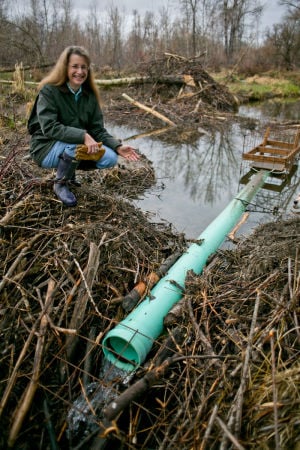This has been a busy month. I knew another pin was going to drop, but Ohio? Who would have guessed?
John Switzer: Beaver moon highlights species’ revival in Ohio
 This month’s moon is called the beaver moon, and it was full Saturday.
This month’s moon is called the beaver moon, and it was full Saturday.
It is called the beaver moon because now is when beaver dens are snug and stocked with food in preparation for the winter. All fall, beavers have been cutting branches and taking them to their dens so that they can dine on the bark and wood. Sounds like a tasty winter meal.
There’s another reason the November moon is called the beaver moon. Hal Borland wrote in the book “Twelve Moons of the Year” that by November the beaver’s pelts are in prime condition. Back during this nation’s settlement, beaver hats were all the rage here and in Europe, and pelts were considered the same as currency. Their pelts were so desired that by the 1830s, beavers had been extirpated from Ohio, said Jim McCormac, a wildlife biologist.
But beavers are again relevant because they have returned to all 88 Ohio counties, entering the state from the north and east, McCormac said. McCormac said Ohio is home to an estimated 30,000 beavers. He also said that if beavers live in your area, its biodiversity and natural heath are profiting “big-time.”
Many plants and animals benefit from beaver dams and the ponds they create. He gave the example of the beautiful wood duck, whose population is increasing partly because of beaver dams.
“There are no better ecological engineers,” McCormac said of beavers.

But having beavers in the area is not without its negative consequences. When they dam up creeks and streams, they sometime cause the flooding of farmland and other places that humans rely on.
I’ll give you an example. Early last spring I went out to Glacier Ridge Metro Park near Dublin and the park’s wetlands and a few of the nearby bike trails and hiking paths were covered by water. Beavers had dammed up the small stream that flows through the area and, by the end of the winter, caused a small flood.
But all was not lost. The Columbus and Franklin County Metro Parks placed pipes through the dam so the water level could be easily lowered mechanically. “That allows us to drop the water down and not interfere with the beavers’ activities,” said Peg Hanley, spokeswoman for the parks system.
WOW! Jim McCormac is a wildlife biologist who knows his beavers! My goodness that’s exciting to read from the state. You can tell the columnist, John Switzer of the Columbus Dispatch, is not exactly sold on the flat tailed animals yet – but this article is a formidable start. I’m terribly pleased!
I was so impressed that I had to go searching for Jim McCormac and found his nature blog, Ohio birds and  biodiversity. It is a wonderful collection of photographs and information. Jim is photographer and a self-described naturalist. The website has been around since 2007!
biodiversity. It is a wonderful collection of photographs and information. Jim is photographer and a self-described naturalist. The website has been around since 2007!
“I am a lifelong Ohioan who has made a study of natural history since the age of eight or so – longer than I can remember! A fascination with birds has grown into an amazement with all of nature, and an insatiable curiosity to learn more. One of my major ambitions is to get more people interested in nature. The more of us who care, the more likely that our natural world will survive.”
Obviously his site has enough respect and readers to get attention, and his opinions about beavers are making a difference. Thanks Jim! You are welcome any year at our beaver festival!





 The entire document is well prepared with a few jarring exceptions. It has the requisite shocking photos of dead beavers in traps or piled on trucks (which won’t do much in court), and isn’t careful about language enough for my tastes. (That paragraph alone spells “ensure” two ways without explanation) but its a HUGE shot across the bow, and every one from Michael Pollock to Ann Riley to Michael Callahan wrote me VERY interested in this yesterday. The reference section is thorough, indeed.
The entire document is well prepared with a few jarring exceptions. It has the requisite shocking photos of dead beavers in traps or piled on trucks (which won’t do much in court), and isn’t careful about language enough for my tastes. (That paragraph alone spells “ensure” two ways without explanation) but its a HUGE shot across the bow, and every one from Michael Pollock to Ann Riley to Michael Callahan wrote me VERY interested in this yesterday. The reference section is thorough, indeed.








 For CFC’s inaugural Beaver Month we chatted with Andrew Jakes, Regional Wildlife Biologist for National Wildlife Federation about the unsung bucktooth heroes of the watershed – the beaver.
For CFC’s inaugural Beaver Month we chatted with Andrew Jakes, Regional Wildlife Biologist for National Wildlife Federation about the unsung bucktooth heroes of the watershed – the beaver.
 Amy will share facts of about beaver ecology, review how beaver act as ‘ecosystem engineers’ in western watersheds, and share the implications lost beaver habitats on our water budget. Chadwick will be joined by Andrew Jakes, Wildlife Biologist with the National Wildlife Federation for a discussion of beaver habitat recovery work underway in the Upper Clark Fork and a Q & A session.
Amy will share facts of about beaver ecology, review how beaver act as ‘ecosystem engineers’ in western watersheds, and share the implications lost beaver habitats on our water budget. Chadwick will be joined by Andrew Jakes, Wildlife Biologist with the National Wildlife Federation for a discussion of beaver habitat recovery work underway in the Upper Clark Fork and a Q & A session.


































